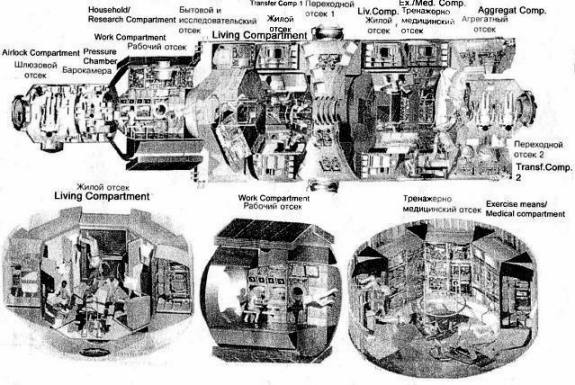
Home - Search - Browse - Alphabetic Index: 0- 1- 2- 3- 4- 5- 6- 7- 8- 9
A- B- C- D- E- F- G- H- I- J- K- L- M- N- O- P- Q- R- S- T- U- V- W- X- Y- Z
Marpost

Forpost
Cutaway of the 6 m diameter Forpost Mars orbiter.
Credit: RKK Energia
AKA: Mars Piloted Orbital Station;RKK Energia. Status: Study 2000. Thrust: 441 N (99 lbf). Gross mass: 400,000 kg (880,000 lb). Unfuelled mass: 399,800 kg (881,400 lb). Specific impulse: 4,000 s. Height: 600.00 m (1,960.00 ft). Span: 280.00 m (910.00 ft).
The expedition would also provide the means for reviving Russian ascendancy in space. The Marpost (Mars Piloted Orbital Station) spacecraft would have a total mass of 400 metric tons and be assembled in low earth orbit from components assembled in four launches of a revived Energia launch vehicle.
As in the 1989 Energia Mars design, it would be powered to and from Mars by matrices of hundreds of solar-powered ion thrusters using xenon as propellant. Unlike the earlier expedition, the crew module would be an enormous 6-m diameter, 28 m long spacecraft housing a crew of six. This module seemed to be a throwback to the TMK-derived modules of the 1960's. Over a total expedition duration of two years the spacecraft would fly to Mars, spend a month or more in Mars orbit, obtain samples from the surface by operation of automated probes, and return to earth. Evidently the large station would be braked into earth orbit on return by the ion engines and was not equipped with a re-entry vehicle.
Based on values in the earlier studies, over half of the 400 metric ton initial mass would be xenon propellant, 100 metric tons for the Marpost station, and the remainder for engines and solar panels. Gorhskov's design was based on proven Russian technology - long-duration life support systems, xenon thrusters, and solar panels. This and massive redundancy and reparability would, he asserted, make the expedition entirely safe.
The cost of the scheme was estimated at 10 billion dollars. A relatively modest one billion dollar per year expenditure would allow Russia and any international partners to reach Mars well before the United States.
In 2001 an International Science and Technology Committee was established to facilitate interaction between Russian and Western scientists regarding plans for a manned expedition to Mars. The committee was composed of eight Russians, eight Americans and five EU delegates. Funding was provided for RKK Energia to coordinate development of a draft project for Marpost. Also involved in the study was the Russian Space Agency, Academy of Sciences, and the Institute for Biological and Medical Problems. In April 2005 it was announced that a 30-volume draft project had been completed for Marpost.
The concept now was for Marpost to be a reusable interplanetary spacecraft. It would fly to Mars using xenon-powered ion engines. The mission scenario was for a crew of six to fly to Mars. The crew would consist of a mission commander, a flight engineer, a physician, a pilot, a biologist, and a geologist. After entering Mars orbit, the pilot, biologist and geologist would take a Mars lander to the surface. After 30 days of scientific investigations, they would return to Marpost, which would then return to earth. It would place itself in orbit near the International Space Station. Total mission time would be 730 days.
A new concept Mars lander, with a mass of only 35 metric tons, had been designed, and a 1:200 scale model was tested in wind tunnels. The lander would bring the crew of three, a Marsokhod rover, and the ascent stage to the surface. The Institute for Biological and Medical Problems was preparing for a crew of six to spend 700 days in a closed-environment ground simulator. However funding was still considered a problem. Energia now estimated average costs of $1.5 billion and total development time at least 12 years. But this was still an order of magnitude less than US estimates, they noted.
Marpost Mission Summary:
- Summary: Russian proposal for a national Mars expedition, using some new elements, at a fraction of the cost of US efforts.
- Propulsion: Nuclear electric
- Braking at Mars: propulsive
- Mission Type: low acceleration
- Split or All-Up: all up
- ISRU: no ISRU
- Launch Year: 2017
- Crew: 6
- Mars Surface payload-metric tons: 35
- Outbound time-days: 415
- Mars Stay Time-days: 30
- Return Time-days: 285
- Total Mission Time-days: 730
- Total Payload Required in Low Earth Orbit-metric tons: 400
- Total Propellant Required-metric tons: 200
- Propellant Fraction: 0.50
- Mass per crew-metric tons: 66
- Launch Vehicle Payload to LEO-metric tons: 88
- Number of Launches Required to Assemble Payload in Low Earth Orbit: 5
- Launch Vehicle: Energia
Crew Size: 6.
Family: Mars Expeditions. Country: Russia. Launch Vehicles: Mars tactical rocket, Energia. Propellants: Electric/Xenon. Agency: Korolev bureau. Bibliography: 499.
Back to top of page
Home - Search - Browse - Alphabetic Index: 0- 1- 2- 3- 4- 5- 6- 7- 8- 9
A- B- C- D- E- F- G- H- I- J- K- L- M- N- O- P- Q- R- S- T- U- V- W- X- Y- Z
© 1997-2019 Mark Wade - Contact
© / Conditions for Use